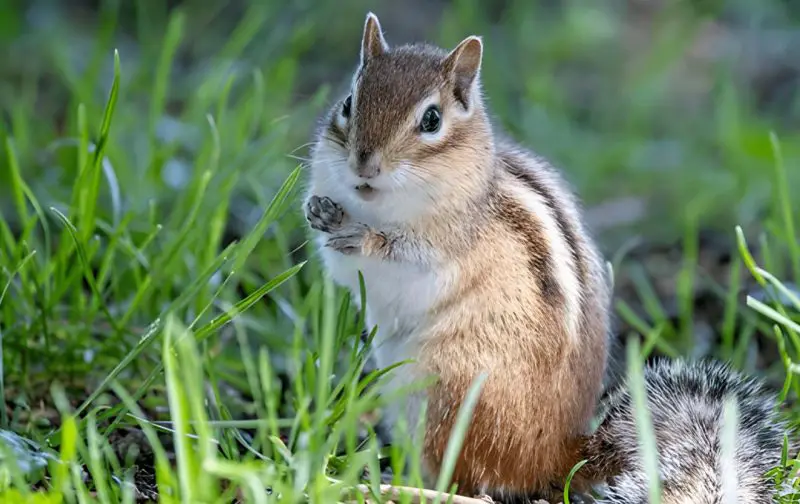Missouri is a state blessed with a variety of wildlife, from white-tailed deer and red foxes to countless bird species and squirrels. But tucked among the fallen leaves, scurrying between tree roots, and darting across garden paths lives one of the state’s most captivating yet often overlooked residents — the chipmunk. These pint-sized creatures are quick, curious, and charming, carrying on their daily lives in ways most people never notice.
While squirrels often get the spotlight in backyards and parks, chipmunks live in a quieter, more secretive world. Yet, if you pause for just a moment to watch them, you’ll see they are highly active, resourceful, and surprisingly important to Missouri’s ecosystems. From their unique stripes to their cheek-stuffing habits, chipmunks bring a spark of life to woodlands and suburban landscapes alike.
In Missouri, the Eastern chipmunk is the main — and only — native species. Understanding how they live, what they eat, and how they behave can open up an entirely new appreciation for this small mammal. Let’s take a closer look at the characteristics, identification traits, behaviors, and habitats of these fascinating little animals.
Missouri’s Only Chipmunk: The Eastern Chipmunk

When it comes to chipmunks in Missouri, there’s no confusion about species diversity — the Eastern chipmunk (Tamias striatus) is the sole representative. This small member of the squirrel family is found throughout the eastern half of North America, and Missouri lies comfortably within its range.
The Eastern chipmunk is instantly recognizable thanks to its reddish-brown fur, accented by five dark brown or black stripes running down its back. Between these dark lines are contrasting lighter stripes, and along each side runs a distinctive white stripe bordered by darker fur. This bold striping pattern sets them apart from tree squirrels and most other small rodents in the state.
An adult Eastern chipmunk typically measures between 8 and 10 inches in total length, with about 5 inches making up the body and the remainder being the tail. Weighing only 2.5 to 4 ounces, they are lightweight and quick, able to dart away from predators in the blink of an eye. Their eyes are large and dark, adapted for spotting danger quickly, and their rounded ears give them an alert, inquisitive appearance.
How to Identify a Chipmunk in Missouri
One of the clearest ways to identify a chipmunk is by its unique striping. Unlike ground squirrels, whose stripes may extend onto their heads, the chipmunk’s dorsal stripes stop at the shoulders. This is an easy field mark for nature watchers to remember.
Their cheeks have pale stripes that run across the face, giving them an expressive and slightly “masked” look. These facial patterns, combined with their fast, twitchy movements, make chipmunks easy to spot once you know what to look for.
Another notable difference from squirrels is their tail. A chipmunk’s tail is shorter, less bushy, and often held upright while running, whereas tree squirrels have long, fluffy tails often draped behind them or wrapped over their backs. Chipmunks also tend to move in quick bursts rather than long, flowing leaps. They frequently stop, sit up on their hind legs, and survey the area before continuing, which can help you spot them even in dense undergrowth.
Behavior and Daily Life
Chipmunks in Missouri are diurnal, meaning they are active during daylight hours. They are busiest in the early morning and late afternoon, especially during spring and fall when food gathering reaches its peak. This daytime activity pattern makes them easier to observe than nocturnal rodents, though their quickness means you need sharp eyes to follow them.
One of their most famous traits is the use of expandable cheek pouches to transport food. These elastic pouches can hold seeds, nuts, berries, and even insects, sometimes swelling so much it appears the chipmunk has doubled its head size. The food is carried back to their underground burrows, where it’s stored in special chambers for later use.
In Missouri, their diet includes acorns, hickory nuts, sunflower seeds, berries, mushrooms, and the occasional insect or bird egg. Their habit of collecting and storing seeds plays a vital ecological role in spreading plants across the landscape. Many of the seeds they bury are never recovered, leading to new plant growth in forests and meadows.
Chipmunk Communication
Though they are small, chipmunks are not silent. They use sharp, repetitive “chip-chip-chip” calls as alarm signals when predators are near. These calls can alert other chipmunks to danger and sometimes serve to distract or confuse the predator itself.
Chipmunks also use body language to communicate, flicking their tails or standing erect to signal alertness. Territorial disputes may involve chasing, chattering, and aggressive posturing, especially during the breeding season or when food supplies are concentrated in one area.
Habitat and Range in Missouri
The Eastern chipmunk is highly adaptable but prefers environments with plenty of cover. In Missouri, they thrive in deciduous forests, woodland edges, shrubby thickets, and areas with abundant leaf litter. They are also common in parks, gardens, and residential neighborhoods with mature trees.
A hallmark of chipmunk life is their burrow system. These underground homes can be surprisingly complex, stretching over 30 feet with multiple entrances. Burrows are divided into specific chambers — some for sleeping, others for storing food, and even waste disposal areas to keep the living space clean. Entrances are often discreetly hidden under logs, rocks, or dense vegetation to avoid detection.
During summer and fall, chipmunks expand their foraging range, sometimes venturing into orchards, farms, or yards in search of food. As winter approaches, their movements shrink back to the immediate area around their burrows. While they do not truly hibernate, they spend most of winter underground, waking periodically to eat from their stored supplies.
Breeding and Raising Young
Chipmunks in Missouri typically breed twice a year, once in early spring and again in midsummer. Mating begins shortly after they emerge from their winter slowdown, with males actively seeking females through scent trails and vocal calls.
After a gestation period of about 31 days, the female gives birth to a litter of 2 to 5 young. Newborn chipmunks are blind, hairless, and helpless, relying entirely on their mother’s care. They remain hidden in the burrow for roughly six weeks before emerging into the outside world.
By the time autumn arrives, the young chipmunks are fully independent. Some will establish territories nearby, while others may disperse farther to find their own home range.
The Role of Chipmunks in Missouri’s Ecosystem
Chipmunks are far more than cute faces in the undergrowth — they are key contributors to the health of Missouri’s natural environments. Their habit of caching seeds ensures that a portion of those seeds will germinate, helping to regenerate forests and maintain plant diversity.
Their burrowing activity aerates the soil, allowing water and nutrients to penetrate deeper layers. This process also creates microhabitats for insects and other small organisms. Additionally, chipmunks serve as an important prey species for predators like hawks, owls, snakes, foxes, and coyotes.
Challenges and Threats
While Eastern chipmunks are not endangered, they do face certain risks. Habitat loss from urban development can limit their access to natural foraging grounds. Roads and traffic present another danger, as chipmunks are quick to dart across open spaces without recognizing the threat of vehicles.
Domestic cats and dogs can also pose significant threats, particularly in suburban areas. Despite these challenges, chipmunks’ adaptability allows them to survive — and even thrive — in many human-modified environments.
Observing Chipmunks in Missouri
If you want to watch chipmunks without disturbing them, the best approach is to remain still and quiet in an area where they are known to forage. Early morning is ideal, as chipmunks are most active then. A pair of binoculars can help you observe their movements and behaviors up close without encroaching on their space.
Creating a chipmunk-friendly yard by planting native shrubs, leaving leaf litter, and avoiding chemical pesticides can encourage visits. While they may occasionally dig in flowerbeds or raid bird feeders, these behaviors are part of their survival strategy, and with proper planning, they can coexist peacefully with human residents.
Fun Facts About Missouri Chipmunks
Chipmunks can carry food weighing as much as their own body weight in their cheek pouches.
They are capable of climbing trees, though they spend the majority of their time on the ground.
Chipmunks maintain clean burrows, regularly removing waste and keeping food storage chambers separate from sleeping quarters.
Their lifespan in the wild is typically 2 to 3 years, though some individuals have been known to live up to 8 years in protected environments.
Conclusion
The Eastern chipmunk may be small, but it is a big player in Missouri’s ecosystems. From seed dispersal to soil health, these lively little rodents contribute far more than their size might suggest. They are energetic foragers, meticulous organizers, and quick thinkers, constantly on the move in a delicate balance between finding food and avoiding predators.
By learning to recognize their markings, behaviors, and habitats, you can start to notice the hidden world of chipmunks that exists right under our noses. The next time you see a flash of stripes disappearing into the brush, you’ll know you’ve caught a glimpse of one of Missouri’s most curious and hardworking residents.
FAQs About Chipmunks in Missouri
What kind of chipmunks live in Missouri?
Missouri is home to the Eastern chipmunk (Tamias striatus), the only chipmunk species native to the state. This small ground squirrel is easily recognized by its reddish-brown fur, bold stripes running down its back, and distinctive white side stripe. They are found in forests, parks, and even suburban neighborhoods.
How can you tell a chipmunk from a squirrel?
Chipmunks are smaller than most squirrels, with shorter, less bushy tails and a distinctive striped pattern on their backs and faces. Unlike tree squirrels, chipmunks spend more time on the ground and store food in underground burrows. Their quick, stop-and-go movements also make them stand out.
What do chipmunks eat in Missouri?
Chipmunks have a varied diet that includes acorns, hickory nuts, sunflower seeds, berries, mushrooms, and occasionally insects or bird eggs. They gather food in their expandable cheek pouches and store it in their burrows for winter consumption.
Do chipmunks hibernate in Missouri?
Chipmunks in Missouri do not fully hibernate. Instead, they enter a period of reduced activity during winter, remaining in their burrows and waking occasionally to eat from their stored food supplies. This semi-hibernation allows them to survive cold months without constant foraging.
Where do chipmunks make their homes?
Eastern chipmunks build elaborate underground burrows with multiple chambers for sleeping, storing food, and waste disposal. These burrows often have more than one entrance and are hidden under logs, rocks, or thick vegetation for protection from predators.
Are chipmunks good for the environment?
Yes, chipmunks play an important ecological role in Missouri. They help disperse seeds, which supports plant growth and forest regeneration, and their burrowing activity aerates the soil, improving nutrient and water movement. They are also a vital food source for many predators.
Can chipmunks damage property or gardens?
While generally harmless, chipmunks may dig in flowerbeds or raid bird feeders. In some cases, their burrows can disturb landscaping. However, most gardeners find that chipmunks cause minimal damage compared to other wildlife, and they can often be managed with habitat-friendly deterrents.






